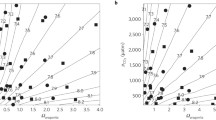Abstract
Sinking rates of the embryos of Euphausia superba were measured during development in the laboratory at Palmer Station. Antarctic Peninsula, during austral summer 1982. Two densities of seawater were used in these experiments; the lower density (1.027 g cm-3) is characteristic of the upper 300 m of the water column, the higher (1.029 g cm-3) is characteristic of the deeper “circumpolar deep water”. During development, the eggs sank at an initial average rate of 175 m d-1, declining to 51 m d-1 during the gastrula to early limb bud stages and increasing before hatching to near initial rates. The larvae hatched within 6 d. We predict that the majority of the embryos of E. superba should hatch at a depth of about 850 m.
Similar content being viewed by others
Literature Cited
Cassie, R.: The analysis of polymodal frequency distributions by the probability paper method. N. Z. Sci. Rev. 8, 89–91 (1950)
Clarke, A.: The biochemical composition of krill, Euphausia superba Dana, from South Georgia.J. exp. mar. Biol. Ecol. 43, 221–236 (1980)
Gordon, A.L.: Structure of Antarctic waters between 20°W and 170°W. Antarctic Map Folio Ser. 6, 1–24 (1967). (Folio Am. geogr. Soc.)
Gordon, A. L., H. W. Taylor and D. T. Georgi: Antarctic oceanographic zonation. In: Polar oceans, pp 45–76. Ed. by M. J. Dunbar.Calgary: Arctic Institute of North America 1977
Harding, J.: The use of probability paper for the graphical analysis of polymodal frequency distributions. J. mar. biol. Ass. U.K. 28, 141–153 (1949)
Hempel, I.: Vertical distribution of eggs and nauplii of krill (Euphausia superba) south of Elephant Island. Meeresforsch. Rep. mar. Res. 27 (Sdbd), 119–128 (1979).(Ber. dt. wiss. Kommn Meeresforsch.)
Hempel, I., G. Hempel and A. de C. Baker: Early life history stages of krill (Euphausia superba) in Bransfield Strait and Weddell Sea. Meeresforsch. Rep. mar. Res. 27 (Sdbd), 267–281 (1979) (Ber. dt. wiss. Kommn Meeresforsch.)
Lehninger, A. L.: Biochemistry, the molecular basis of cell structure and function, 833 pp. New York: Worth Publishers, Inc. 1970
Mackintosh, N. A.: Life cycle of Antarctic krill in relation to ice and water conditions. ‘Discovery’ Rep. 36, 1–94 (1972)
Makarov, R. R.: Life cycle and peculiarities of the distribution of Euphausia superba Dana. Trudy vses. nauchno-issled. Inst. morsk. ryb. Khoz. Okeanogr. 77, 85–92 (1972)
Makarov, R. R.: Some peculiarities of reproduction of Euphausia superba Dana. In: Abstracts of papers, pp 34–35.Moscow: All-Union Research Institute of Marine Fisheries and Oceanography 1973
Makarov, R. R. and V. V. Maslennikov: Some data on vertical distribution of euphausiid larvae on the Antarctic Peninsula shelf. BIOMASS Newsl. (College Station, Tex.). 3, 7–9 (1981)
Marr, J. W. S.: The natural history and geography of the Antarctic krill (Euphausia superba). ‘discovery’ Rep. 32, 33–464 (1962)
Marschall, H.-P..Sinking speed, density and size of euphausiid eggs. Meeresforsch.Rep. mar. Res. 30, 1–9 (1983). (Ber. dt. wiss. Kommn Meeresforsch.)
Marshall, S. M. and A. P. Orr: Calanus finmarchicus: egg production and egg development in Tromsø Sound in spring. Acta boreal. (A. Scientia) 5, 1–21 (1953)
Mauchline, J. and L. R. Fisher: The biology of euphausiids, 454 pp. New York: AcademicPress 1969
McNown, J. S. and J. Malaika: Effects of particle shape on settling velocity at low Reynolds numbers. Trans. Am.geophys. Un. 31, 74–82 (1950)
Quetin, L. B. and R. M. Ross. School composition of the Antarctic krill, Euphausia superba, in the waters west of the Antarctic Peninsula, austral summer 1982. J. Crustacean Biol. (Lawrence, Kansas) (In press). (Proc. Ist int. Krill Symp. Wilmington, N. C., October 16–18, 1982)
Ross, R. M. and L. B. Quetin: Euphausia superba: fecundity and the physiological ecology of its eggs and larvae. Antarctic J. U.S. 17, 166–167 (1982)
Ross, R. M. and L. B. Quetin: Spawning frequency and fecundity of the Antarctic krill Euphausia superba. Mar. Biol. 77, 201–205 (1983)
Sokal, R. R. and F. J. Rohlf: Biometry. The principles and practice of statistics in biological research, 776 pp. San Francisco: W. H. Freeman & Co. 1989
Vogel, S.: Life in moving fluids, 352 pp. Boston, Mass: Willard Grant Press 1981
Voronina, N. M.: An attempt at a functional analysis of the distributional range of Euphausia superba. Mar. Biol. 24, 347–352 (1974)
Author information
Authors and Affiliations
Additional information
Communicated by N. D. Holland, La Jolla
Rights and permissions
About this article
Cite this article
Quetin, L.B., Ross, R.M. Depth distribution of developing Euphausia superba embryos, predicted from sinking rates. Mar. Biol. 79, 47–53 (1984). https://doi.org/10.1007/BF00404984
Accepted:
Issue Date:
DOI: https://doi.org/10.1007/BF00404984




